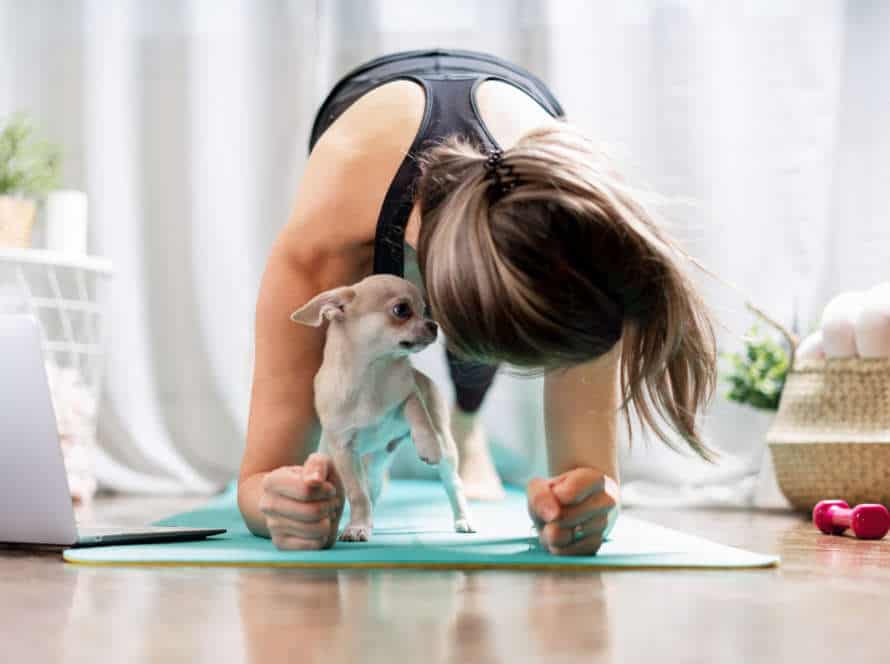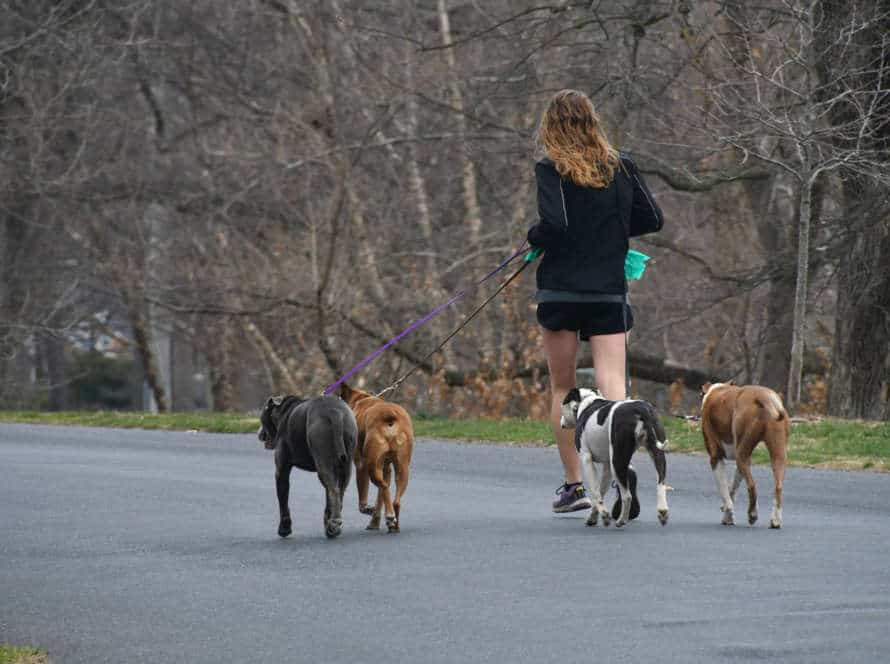A Dog Owner’s Guide to Fun and Effective Exercise
Create a fun and effective exercise routine for your furry best friend! It can benefit both physical and mental wellbeing. Here’s a dog owner’s guide.
Different dogs have different needs based on age, breed, size & health condition. Daily walks or runs help burn off energy & keep a healthy weight.
Interactive toys such as frisbees, balls & tug ropes are great exercises, improving agility & coordination.
Enrolling in obedience or agility classes can benefit their health & provide socialization.
Before starting a new routine, consult your vet, especially if your dog has medical conditions.
Combine daily walks, playtime, training classes & vet-approved exercises. This will keep your furry friend happy & healthy!
Why Exercise is essential for your dog
Exercise is vital for your pup’s health and liveliness. It not only helps with physical fitness but also stimulates the mind, encourages self-assurance and even stops behavioural problems. From just taking a walk or running, to complex training and agility exercises – there are many activities you can do to keep your furry friend active. Let’s look into why exercise is so important, plus the different types of physical activity you can give your canine pal.
The Health Benefits of Exercise for Dogs
Exercising is a must for keeping your pup healthy. It can boost their mental and physical health, and ward off obesity, heart disease and other issues. Plus, it strengthens your bond with them and creates lots of fun!
Here are the major benefits of exercise for dogs:
- Improved physical health: Regular exercise helps build cardiovascular strength, respiratory function, and musculoskeletal well-being.
- Weight control: It’s one of the best methods to maintain your pup’s weight and steer clear of obesity.
- Mental stimulation: Exercise reduces stress, depression, and bad behaviour in dogs.
- More socialization: It gives doggos the chance to mingle with other canines and people.
Remember, tailor the exercise schedule to your dog’s breed, age, size, and overall health. Talk to your vet to make sure the routine is safe and enjoyable for your furry friend.
Pro tip: Vary your pup’s workout to keep them engaged and active. Try out new activities to discover which one your dog loves the most.
Positive Effects of Exercise in Dog’s behavior
Exercise is vital for your dog’s physical and mental health. It has many benefits for their behavior such as:
- Reducing anxiety. Exercise relieves stress and helps calm nerves. So, your pup will be less likely to act out.
- Promoting relaxation. Exercise helps dogs sleep better and be less hyper.
- Boosting confidence. Exercise builds up your pup’s self-esteem which means better behavior.
- Improving socialization. Exercise gives your pup chances to meet other humans and dogs positively.
As a dog owner, it’s important to create a fun and beneficial routine. This should fulfil your pup’s needs while keeping them healthy and content. Regular exercise and a balanced diet are essential to maintain your pup’s wellbeing.
Exercise as a way to prevent Obesity
Exercise is a must for dogs. Physical activity can help prevent obesity and other health issues. As a dog owner, it’s important to know how exercise affects your pup’s health.
Working out can help them keep a healthy weight, build and sustain strong muscles and bones, and reduce the risk of joint problems. Exercise also boosts heart health, activates the mind, and is awesome for bonding.
Fun and effective exercises are: walking, running, hiking, swimming, and playing fetch. Choose exercises that are right for your dog’s age, breed, and fitness level. Avoid strenuous activities in severe weather.
Include regular exercise in your dog’s routine. This can stop obesity and make them healthier and happier.
Types of Exercise for Dogs
Exercise is key for your pup’s physical and mental health. To keep fit, there are lots of activities to choose from. These include:
- going for walks
- running
- swimming
- playing ball
- agility courses
Let’s dive deeper and learn more about the benefits of these fun activities for your doggo!
Walks
Exercising regularly is important for your pup’s physical and emotional health. Walks are a great way to do this. Here are a few kinds of walks you can take your pup on:
- Neighborhood Walks: Around your area or the local park. Perfect for puppies, older dogs and those with health issues.
- Hiking: If you and your pup love the outdoors, go hiking! Make sure to choose a pup-friendly spot and bring water.
- Interval Walks: A mix of fast and slow speeds. Helps burn calories, build endurance and increase metabolism.
- Dog Parks: Let your pup play, run and socialize in a controlled environment. Always supervise and bring water.
Walking is a great way to bond with your pup and keep them healthy. So grab the leash and get moving!
Different Walking Routines
For your furry companion, there’s a range of walking routines to choose from. Each one has its own advantages, and can be adapted to fit your pup and your lifestyle. Think about your dog’s age, health, and personality before selecting one. An enjoyable exercise plan can improve your pet’s health and happiness.
Options include:
- Brisk walking – quick, moderate intensity for high-energy dogs.
- Interval walking – alternate between brisk and relaxed periods for a high-intensity workout with recovery time.
- Long walking – slower pace for longer periods of time.
- Social walking – walk with other dogs for socializing and exercise.
- Hiking – explore on uneven terrain for a full-body workout.
Playtime
Playtime is a must for a dog’s health. There are various kinds of exercises to keep your pup content, healthy and amused. Here are some:
- Fetch: An old-fashioned game of fetch is both entertaining and good for your dog’s agility and coordination.
- Swimming: Swimming is a low-impact exercise which is great for dogs with joint issues and also builds heart endurance.
- Hiking: Hiking lets you and your pup explore new places and get some exercise while bonding.
- Agility Training: This helps fitness and stimuli.
- Tug of War: This game strengthens your dog and keeps their teeth clean.
Make sure to adjust the exercise to suit your dog’s breed, age and physical abilities for best results.
Different Play Time Activities
As a dog owner, providing your pup with regular exercise is essential for their wellbeing. To make things fun, there are many exercises and activities you can do with your dog. Here are some ideas:
- Fetch – a great way to get your pup moving and expending energy.
- Tug of War – this game helps strengthen your dog’s jaw, neck, and shoulder muscles and also provides a nice bonding experience.
- Hide & Seek – use your dog’s sense of smell and give them mental stimulation.
- Agility Courses – obstacles like tunnels, weave poles, and jumps give your dog physical and mental stimulation.
- Swimming – a low-impact exercise that is great for all ages and abilities, providing cardiovascular and muscle-building benefits.
Pro tip: Change up your pup’s routine to keep them interested in staying fit!
Swimming
Swimming is a great workout for dogs! It’s easy on their joints, plus it builds their strength and increases their endurance. It’s great for hot summer days, and helps to reduce destructive behavior and anxiety. It’s also great for older dogs with arthritis or joint pain, and can even be used for rehabilitation after an injury.
If you plan on taking your pup for a swim, start slow and make sure to choose a safe spot. Invest in a life jacket for extra safety. Supervise them in and around the water. Enjoy!
How to Safely Introduce your Dog to water
Dog owners, introducing their furry friend to water can be fun and exciting. But it’s important to make sure it’s safe. Here are tips for a safe introduction:
- Start slow. Use a kiddie pool or shallow stream.
- Use positive reinforcement. Praise and give treats when they approach or get in the water.
- Consider a life jacket. If new to swimming or uncomfortable, a life jacket can help keep them afloat and calm.
- Stay in control. Use a leash to keep close and prevent from going too far or entering dangerous areas.
These tips will help you safely introduce your dog to swimming and create a positive bonding experience.
Exercising with your Dog
An active pup can bring joy! But, it can also be a challenge. Exercise with your dog and bond. It’s good for their health. Plus, it’s a great workout for you both. And, it helps build a special connection!
Let’s look at how to exercise with your pup in creative ways. Have fun!
How to Incorporate Your Dog in your Exercise Routines
Working out with your pup can be both fun and beneficial! Here’s how:
- Start slow – walks or jogs, and gradually increase intensity and duration.
- Pick activities that your pup loves – running, fetch, hiking, swimming, etc.
- Invest in the right stuff – a strong leash, a comfy harness, doormats.
- Watch for signs of exhaustion – hydrate them, rest frequently.
Exercising with your pup is a great way to bond and boost your health. Keep safety and happiness top of mind.
Pro tip: Try agility training or dog yoga (doga) for an extra challenge.
Exercises to Train your Dog while Exercising
Exercising with your pup? Here’s the perfect way to have fun and stay fit! Train your dog while you exercise to help improve their physical and mental wellbeing. Plus, it’ll build a stronger bond between you two. Check out these exercises:
- Running: No matter your skill, join your pup on a jog. Start slow and gradually increase speed and distance.
- Fetch: Find a spacious area and toss a frisbee or ball for your pup to catch.
- Tug-of-war: Get a strong rope or durable toy and engage in a friendly match.
Pro Tip: Remember your pup’s abilities and adjust intensity accordingly. Drink plenty of water when exercising with your furry friend.
Benefits of exercising with your Dog
Working out with your pup has many great benefits; not only for them, but for you too! Here are the top advantages of exercising with your doggo:
- Fitness Boost: Doing regular activity with your pooch helps to improve your heart health, build muscles/bones and promote weight loss.
- Strengthen Bond: Exercising and playing together helps you get closer and strengthens the loyalty and love between you.
- Stress/Anxiety Reduction: Going outdoors with your pup can help to reduce stress, lower anxiety and make you feel better.
- Socializing: Walking or running with your pup can give you the chance to meet new people and other pups, making it more fun.
- Consistent Exercise: Having a dedicated exercise buddy, like your pup, helps make sure you stay on track and motivated.
Exercise equipment for Dogs
Exercising your pup can keep them healthy and fit! You can get special exercise equipment to help them out. Treadmills, jumps, and tunnels are just some of the choices. To make exercising your dog enjoyable and productive, here are some of the options available.
Types of Exercise equipment
It’s easy to keep your furry friend happy and active with the range of exercise equipment available! Options include:
- Treadmills: Just like human treadmills, these have speed settings, inclines, and programs. Perfect for bad weather or when outdoor exercise isn’t possible!
- Fetch Machines: These launch balls or toys for your pup to chase. Different sizes and designs available for all breeds.
- Agility Kits: Obstacle courses for your pup to climb, weave, and crawl through. Suitable for indoor and outdoor use.
- Weighted Vests: These add resistance to your pup’s workout and help build strength. Choose one suitable for your pup’s size and strength.
- Swimming Pools: A great way to get your pup to exercise and cool off! In-ground or above-ground pools designed for dogs.
Before buying any exercise equipment, consider your pup’s age, size, and health condition. Ensure it’s safe and easy to use. Also, check with your vet before starting a new exercise routine.
How to choose the right Equipment for Your Dog’s Needs
To pick the perfect exercise equipment for your pup, consider its size, breed, age and activity level. Here are some popular options:
- Frisbees and Balls: Stimulate your pup’s instinct to chase and encourage exercise. Make sure to choose the right size and material for your pup’s breed and chewing habits.
- Agility Course: Perfect for high-energy dogs. Improves coordination, speed, and agility. Get a course that fits your pup’s size and is easy to set up.
- Treadmill: Great for indoor exercise. Low profile and adjustable speed to suit your pup’s needs.
- Swimming Pool: A low-impact workout for dogs with joint issues. Pick a shallow pool with no sharp edges or fittings.
Always supervise your pup and talk to a vet or dog trainer before starting a new exercise routine.
Budget-friendly Exercise Equipment
Need budget-friendly exercise equipment for your pup? Here are some great, fun options:
- Agility Hoops: Teach ’em to jump and weave through obstacles. Good for agility and coordination.
- Treadmill: Perfect for days when it’s too wet or too late for outdoor exercise.
- Interactive toys: Treat-dispensing balls and puzzles get their minds and bodies working.
- Flirt Pole: Playful activity that builds their endurance and coordination.
These will keep your dog active, healthy and happy. Have fun and stay fit!
Common mistakes to avoid during Exercise
Exercising with your pup is a top-notch way to bond and keep them healthy! But there are some common blunders dog owners make. To make sure your pup gets the most out of their exercise, be aware of these mistakes. Here, we’ll talk about the common missteps to avoid while exercising with your furry friend.
Over-exercising your Dog
Over-exercising your dog is a no-no. Exercise is important for your pup’s health and happiness, but too much can be bad. Here are some tips to avoid over-exercising:
- Don’t do high-impact exercises like jumping or running for long.
- Consider your dog’s age, breed, size, and fitness level before starting a workout.
- Provide water and rest breaks during exercise.
- Avoid exercising in extreme weather.
- Look out for signs of fatigue, injury, or discomfort.
Keep these tips in mind and your pup will have fun and stay healthy!
Exercising on hot weather
Exercising in hot weather can be tough. But with the right precautions, you can stay safe and healthy while getting your workout in. Here are some mistakes to avoid:
- Wearing tight, dark clothes. Go for loose-fitting, light-colored clothes made of breathable materials. This helps wick away sweat and keep you cool.
- Not hydrating properly. You need to drink enough fluids before, during, and after. Don’t wait till you’re thirsty.
- Pushing too hard. Listen to your body. If you feel dizzy, nauseous, or have a headache – slow down or take a break.
- Not taking breaks. Breaks help lower your body temp and reduce the risk of heat exhaustion.
By being aware of these mistakes, you can make your workout safe and enjoyable even in hot weather.
Forcing your Dog to exercise
It’s never okay to force your pup to work out. This can cause physical and behavioural problems. To make sure exercising is fun and safe for you and your pup, avoid these common blunders:
- Don’t push young or older pups over their limits. It could lead to injuries.
- Make sure your pup takes hydration breaks.
- Don’t exercise in the hottest part of the day. Go for morning or evening instead.
- Don’t do strenuous activity right after eating. It can cause digestive issues.
- Stick to activities your pup loves and is comfy doing.
These tips will make exercising fun and effective. Plus, reward your pup with treats and love after each session. Positive reinforcement works wonders!
Dog’s physical limitations and exercises to avoid
To craft a secure and efficient workout routine for your pup, you must comprehend their physical contraints. Dogs are not people, so their restrictions are unlike ours.
Here, we’ll zoom in on the diverse exercises to dodge when making a routine for your pup. Moreover, we’ll go over alternatives for those exercises that you can use to keep your pup fit and thriving.
Factors to consider before exercising with Your Dog
Prior to commencing an exercise plan with your pup, there are some essential elements to contemplate to make sure your furry pal remains safe and sound. Keeping these in mind is key:
- Your Dog’s Age: Puppies and senior dogs may possess physical restrictions that necessitate extra care during exercises. Confer with your vet to come up with a workout plan suitable for your dog’s age and physical condition.
- Your Dog’s Health: If your pooch has health issues such as arthritis, obesity, or heart disease, tailor-made exercises may be necessary to avert causing harm or discomfort.
- Your Dog’s Breed: Different breeds of dogs have diverse energy levels and physical features that must be taken into consideration when devising an exercise program.
- Avoid High-Impact Exercises: High-impact exercises, e.g. jumping or intense running, should be avoided for dogs with joint problems or more mature dogs. Rather, try lower-impact exercises like swimming or walking to avoid injury.
- Pro Tip: Always warm up your dog prior to beginning an exercise routine and cool down afterwards to dodge injuries.
Signs that your Dog May be Overexerted
Dog owners need to know the signs of over-exertion to keep their furry friends safe. Look out for:
- Heavy panting. Difficulty breathing? Over-exertion might be the cause.
- Lethargy. If they’re too tired to move, it’s a warning sign.
- Dizziness or stumbling. Loss of balance? Could be a red flag.
- Vomiting. After exercise, if your pooch throws up, it’s a sign.
To avoid over-exertion, don’t overexert your dog in hot weather or during intense exercise. Make sure their physical limits are respected. Provide them with hydration and rest periods too.
Injuries caused by incorrect Exercises and how to Prevent Them
Incorrect exercises can cause common injuries in dogs. It’s important to know which ones to avoid in order to keep them healthy and pain-free. Understand your pup’s physical limitations for effective exercise.
Here are some exercises to avoid:
- Strenuous exercise, especially in older dogs or those with health issues/joint problems. No long runs or hikes that cause fatigue or strain joints.
- High-impact exercises like jumping and catching frisbees can lead to joint, muscle or bone injuries and chronic pain.
- Repetitive movements and overexertion can cause strains or sprains. Give your dog rest days between workouts to avoid strain.
Low-impact exercises like walking, swimming and gentle tug-of-war games maintain your pup’s health without harming physical limitations.
Pro tip: Pay attention to your pup’s body language while exercising and their breathing/heart rate to avoid injuries.
Frequently Asked Questions
Q: How much exercise does my dog need?
A: The amount of exercise your dog needs depends on their breed, age, and health status. As a general guideline, dogs should get at least 30 minutes of exercise per day, but some breeds will require much more.
Q: What are some fun exercises I can do with my dog?
A: There are many fun exercises you can do with your dog, including playing fetch, going for a hike or walk, swimming, running, and agility training.
Q: Can I exercise with my dog indoors?
A: Yes, there are plenty of indoor exercises you can do with your dog, such as playing hide and seek, doing indoor fetch, or practicing basic obedience training.
Q: How do I know if my dog is getting enough exercise?
A: You can tell if your dog is getting enough exercise by their behavior. If they seem content, happy, and tired after exercise, chances are they are getting enough. Additionally, a veterinarian can help you determine how much exercise is appropriate for your dog.
Q: What are some safety tips for exercising with my dog?
A: Some safety tips for exercising with your dog include starting slow and gradually increasing activity levels, avoiding exercising during extreme weather conditions, bringing plenty of water, and keeping your dog on a leash in public areas.
Q: How do I motivate my dog to exercise?
A: You can motivate your dog to exercise by making it fun and using positive reinforcement techniques. Treats, toys, and excitement in your voice can all help your dog get excited about exercise time.







